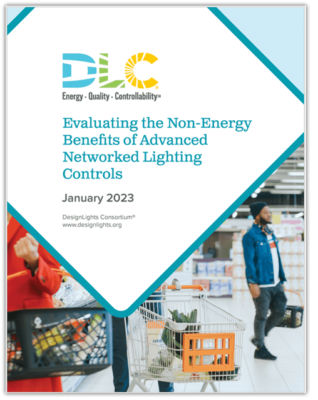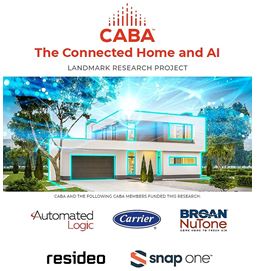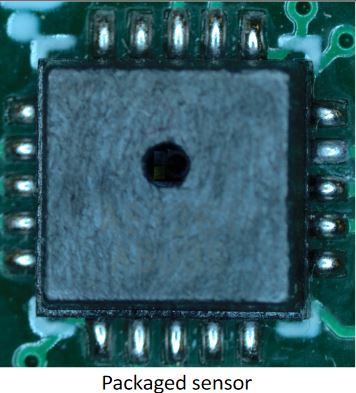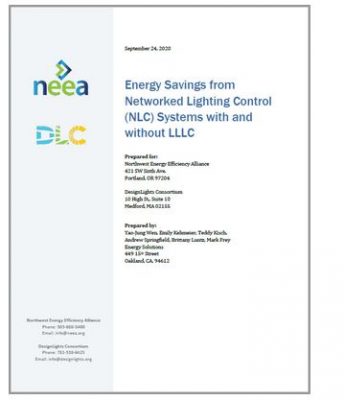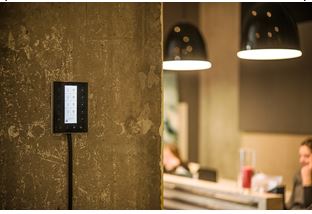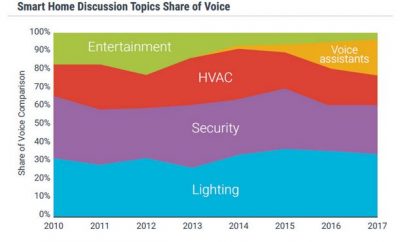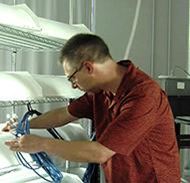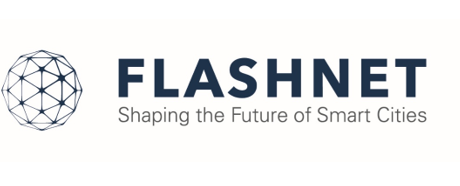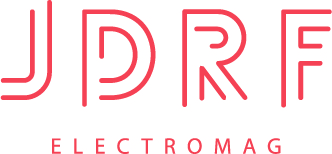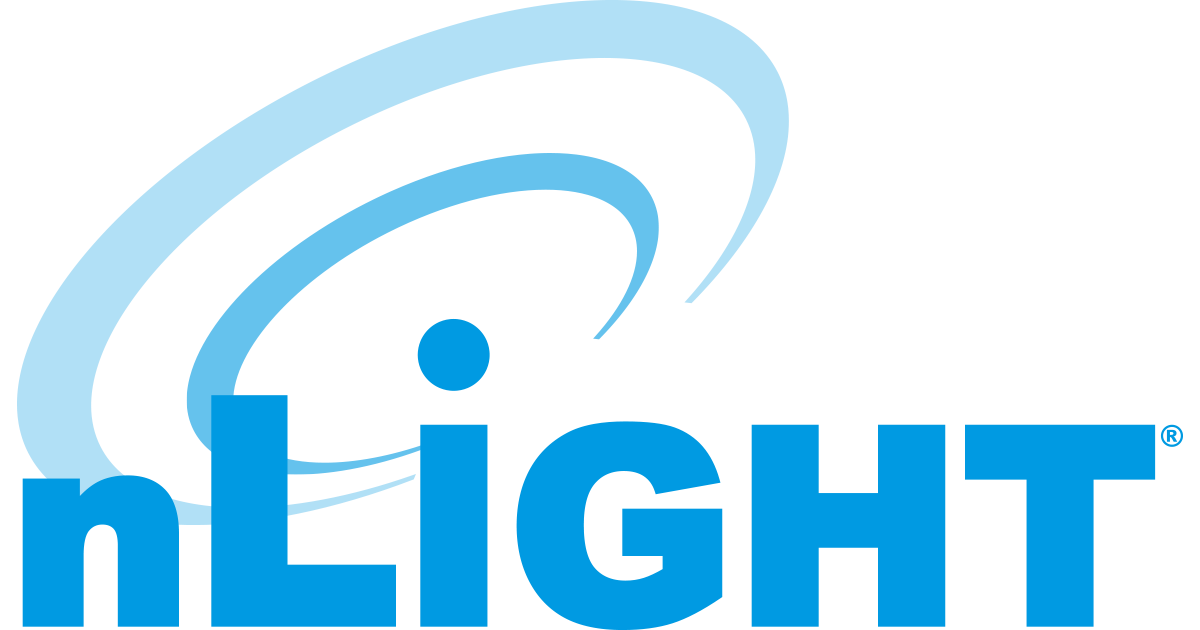
Cumulative energy and cost savings delivered by dimming curves from all luminaires characterized in this study, for one PND strategy (red) and two CLO strategies—L90 at 20 years (green), L80 at 16 years (violet)—relative to the full rated power baseline. The gray shaded columns represent ANSI C137.1-2022 noncompliant products. Notably, L-3, L-9, and L-23 are three units of the same make/model streetlight.
To improve understanding and possibly resolve the shortcomings of 0-10V products, the Department of Energy recently published the results of a study conducted by Pacific Northwest National Laboratory (PNNL). The study characterized 23 LED streetlights that claimed dimmability via a 0-10V interface, quantified the performance variation found in market-available LED drivers, and explored the potential impact of the most recent 0-10V voluntary standard, ANSI C137.1-2022.
The DesignLights Consortium has released a request for proposals for a consultant to create process maps for commercial lighting project life-cycles.
The DLC recently published a summary of research conducted by Skumatz Economic Research Associates, Inc. (SERA), which identified non-energy benefits (NEBs) of networked lighting controls and developed a methodology for quantifying them.
Despite the potential benefits and variety of conditions that tunable lighting systems can provide, research documenting occupant preference in healthcare settings is sparse. Recently, researchers at PNNL and Georgia Institute of Technology’s SimTigrate Design Lab partnered on a study of patient preference for tunable light.
In senior care centers, tunable LED lighting system retrofits can save energy, reduce operating costs, and improve quality of life for occupants when compared to outdated fluorescent systems that are still used in many facilities nationwide. A recent study suggests that LED tunable lighting system retrofits can offer energy savings and reduced costs, along with the possibility of improved quality of life for residents.
Smart home companies can help catalyze a growing opportunity by prioritizing data privacy, says a new report by CABA prepared by Harbor Research.
As it seeks to quantify the non-energy benefits of networked lighting and advanced building controls, the DesignLights Consortium (DLC) is seeking the input of facility managers for a short online survey. Results of this research will yield monetized estimates useful for product marketing, efficiency program incentive promotion, and facility management decision making.
Two of the best investments building owners and corporate tenants can make to improve employee well-being and energy efficiency are automated shading systems and modern LED lighting with advanced wireless controls, says Controlling Comfort and Energy in Offices, a new publication by the New Buildings Institute.
The U.S. Department of Energy has released a report on the initial performance and reliability of chromaticity sensors used for tunable LED lighting systems.
The California Energy Alliance (CEA) recently announced that it has been awarded funding via the California Energy Commission (CEC) solicitation GFO-20-303 for applied R&D and technology demonstration projects that advance innovative technologies for controlling plug load and exterior lighting energy use.
The Continental Automated Buildings Association (CABA) recently released the Executive Summary of its Intelligent Building Energy Management Systems Landmark Research Project, providing a detailed exploration of the current state of the market.
A U.S. Department of Energy-funded Pacific Northwest Energy Laboratory (PNNL) study found that hospital nurses value controllability in lighting and that this controllability can translate to greater satisfaction among patients.
The Northwest Energy Efficiency Alliance (NEEA) and the DesignLights Consortium (DLC) recently released results of a new study that strengthens the case for expanding use of networked lighting controls (NLC) to significantly drive energy savings in commercial and industrial buildings. The report found that energy savings possible by adding NLCs to LED lighting projects approach 70 percent for some building types, with savings across various categories of buildings averaging 49 percent.
The Pacific Northwest National Laboratory (PNNL) is gathering market data from DC lighting and DC microgrid controller manufacturers and solution providers to characterize the current states of these two technologies and their interoperability. The responses will help inform future research needs to advance DC lighting technology and DC building microgrids, with the ultimate goal of increasing energy efficiency and resilience while enabling Zero Energy Buildings.
The Lighting Research Center (LRC) at Rensselaer Polytechnic Institute will present a love, one-hour webinar, “Lighting Controls: What works? Lessons from the Field” from 1-2 PM ET on January 14, 2020.
The Lighting Research Center (LRC) recently published a new DELTA report evaluating new sensor-controlled LED corridor lighting installed in a multifamily residential building in Albany, New York. The project showed significant energy savings while overall occupant response was positive.
Early in 2019, ELECTRICAL CONTRACTOR conducted a survey developed by Craig DiLouie, LC, CLCP to gauge familiarity with major lighting trends, including networked lighting controls and wireless controls. Here are some key findings.
A study covered in the 2018 Consumer Electronics Guide revealed positively trending sentiments toward smart home technology, with lighting and security being the most discussed topics.
A new exploratory study conducted in the Department of Energy’s Connected Lighting Test Bed investigates energy losses in Ethernet cables used between PoE switches and luminaires in PoE connected lighting systems.
To accelerate advances in connected lighting systems, DOE developed a connected lighting test bed (CLTB) in 2016 to characterize the capabilities of market-available connected lighting systems. The results will increase visibility on what does and does not work, and create tight information feedback loops to inform technology developers about needed improvements related to interoperability, configuration [...]
In a 25,000-square-foot commercial office on the Rensselaer Technology Park campus in Troy, N.Y., scientists from the Lighting Research Center (LRC) at Rensselaer Polytechnic Institute are making plans to install LED lighting with fixture-integrated and network-connected lighting controls. The controls are being tested in a broad-based field evaluation to compare and quantify the additional benefits [...]
Vehicles are expected to play a big part in the Internet of Things. By 2020, 250 million connected vehicles will be on the road, creating new services and driving capabilities, according to Gartner, Inc. Infotainment is high in demand, though other capabilities are enabled, including crash warning, traffic violation warning and relaying weather, traffic and [...]
The U.S. Department of Energy (DOE) has begun releasing results from the 2012 Commercial Buildings Energy Consumption Survey (CBECS). The CBECS is an estimated profile of the U.S. commercial building stock based on an interviewed sampling. Information includes number of buildings, floorspace, age, building type, region, energy consumption, end-use equipment and more. DOE defines a [...]
Given current adoption of commercial building energy codes, conventional wisdom indicates that LED lighting is frequently specified with automatic lighting controls. However, there is little public data available concerning market penetration of LED lighting, how often it is specified as controllable and with lighting controls, owner preferences, and how satisfied specifiers and installers are with [...]
The Alliance for Solid-State Illumination Systems and Technologies (ASSIST), a program of the Lighting Research Center (LRC) at Rensselaer Polytechnic Institute, recently released a new publication that addresses the issue of how lamps should dim in terms of their “look and feel” during the dimming process. The publication, ASSIST recommends… Dimming: A Technology-neutral Definition, provides [...]
In September 2012, the Lawrence Berkeley National Laboratory published, Responsive Lighting Solutions for the General Services Administration (GSA). The report provides insight into the viability of highly responsive lighting control systems. It reports the results of installing advanced lighting controls in five Federal buildings. The existing lighting in these buildings was upgraded. A number of [...]
The Lighting Controls Association has announced the results of a recent survey of regular site users. The purpose of the survey, which was distributed to 15,000 subscribers of the LCA newsletter lightingCONTROL, was to determine satisfaction with the LCA website as well as the popularity of potential features. Respondents totaled 241, or 1.6%. The first [...]
Lighting quality is a critical consideration in effective lighting design, and often should take priority over energy savings and the economies of cost. But what is lighting quality? It goes beyond energy and cost and light levels to include brightness, light distribution, color, aesthetics, daylight, ease of use for controls, and other issues. While many [...]
Lighting accounts for about a third of electrical energy consumption in commercial buildings. As advanced energy-saving lighting controls still have a minority penetration in the existing building stock, building owners have a major opportunity to reduce energy costs with lighting control. Adoption of advanced lighting controls faces the usual hurdles affecting all energy-efficient lighting, including [...]
“If you boost the lighting at certain times of day, you’ll get a better performance from workers,” remarks Dr Martine Knoop, a senior lighting specialist at Philips Lighting, commenting on the study that took place at Bartenbach Lichtlabor in Austria. The scientists found in 2007 that if offices used more adjustable lighting, the employees working within them would work more productively.
What are the benefits of combining advanced lighting control strategies in the same space? Are the energy-saving benefits of lighting controls persistent over time? Can advanced lighting controls be successfully applied to open offices given concerns about jurisdiction conflicts, lighting uniformity, etc.? Can they enhance worker satisfaction? A new office lighting field study addresses these questions. Involving about 90 workers in a real-world open-office environment, the one-year study determined that occupancy sensing, daylight harvesting and individual occupant dimming control worked together in the building to produce average energy savings of 47% while correlating with higher occupant environmental and job satisfaction. The study demonstrates that sophisticated lighting control strategies can be combined successfully to generate persistent, large energy savings in open-plan offices while improving occupant satisfaction with their jobs and workspace.



